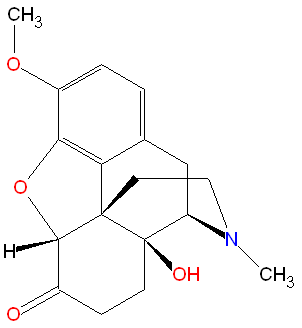Oxycodone
|
| |||||||
| oxycodone | |||||||
| |||||||
| Uses: | analgesic, narcotic | ||||||
| Properties: | opiod antagonist, | ||||||
| Hazards: | see side effects & drug interactions | ||||||
| |||||||
Oxycodone is an opioid analgesic similar to codeine that is marketed with and without additional analgesics, generally NSAIDS, such as aceteminophen and aspirin.
Oxycodone has been the target of robberies of pharmacies.[1][2] After robberies, oxycodone is resold in various ways including through an ice cream truck.[3]
Mechanism of action
Oxycodone is a weak agonist of the mu, kappa and delta opiod receptors of the central nervous system. Oxycodone and other opioids inhibit the release of vasopressin, somatostatin, insulin, and glucagon. Opioids close N-type voltage-operated calcium channels (kappa-receptor agonist) and open calcium-dependent inwardly rectifying potassium channels (mu and delta receptor agonist). This results in hyperpolarization and reduced neuronal excitability. [4]
References
- ↑ Oppmann, P (2011) Addicts putting pharmacies under siege. CNN
- ↑ AP Enterprise: Rising painkiller addiction, ruthless dealers drive US pharmacy robberies. Washington Post
- ↑ Gootman, E. (2011) Staten Island Ice Cream Truck Sold Oxycodone Too, Officials Say. New York Times
- ↑ http://www.drugbank.ca/drugs/DB00497
